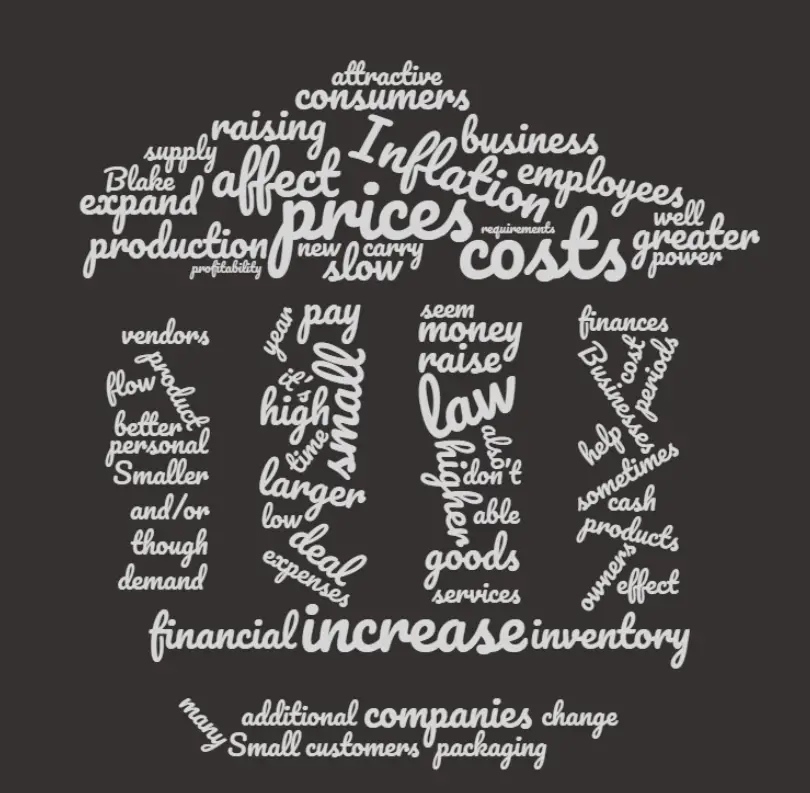By: J. Blake Ledbetter, Conoscienti & Ledbetter

Price inflation is the term that economists use to characterize an increase in the price of goods and services over time, which reduces the purchasing power of the currency. The bite of inflation often can be slow and painful. When inflation rates rise above 5% however they can be devastating to an economy and especially to small businesses.
The rate of inflation is the increase in prices during a specified period. If inflation is at three percent annually, something that costs $100 this year will cost $103 next year. What it means to consumers and businesses is that money doesn’t buy as much.
Inflation can be especially painful for small businesses.
A small business is defined as any company that has fewer than 500 employees. More than 99-percent of all companies in the United States are classified as small businesses. Inflation has a greater effect on small businesses. Less buying power means a decreased ability to hire employees and/or expand. Small businesses are often financed by their owners’ personal savings. This puts the owners at greater financial risk during periods of high inflation.
To understand how inflation can affect small businesses, it’s important to understand what causes inflation.
One cause of inflation is demand outpacing the supply of goods and services. Another occurs when supply is restricted but demand is not. You see this occur with gas prices when oil refineries shut down or slow production because of severe storms, etc.
But both of these are short-term anomalies and not a cause of long term systemic price inflation.
Longer-term price inflation is generally caused by an increase in the money supply (i.e. monetary inflation) usually engineered by central banks in an effort to stimulate the economy.
Big businesses often appear unaffected by hikes in inflation due to their longer term perspective and larger financial reserves. Even though people may think small businesses are just the same as big businesses but on a smaller scale, this is not the case.
Smaller companies often deal with what may be termed “resource poverty,” meaning that they don’t have the same access to financial liquidity as their larger counterparts. The owner’s or partners’ salaries take a much larger portion of revenue, sometimes leaving little to pay investors or expand.
One of the major side effects of inflation (besides increasing prices) is that it makes cost forecasting more difficult since decision makers don’t know if the current inflation rate will hold or drastically increase over the next 1, 2 or 5 years.
Thus external forces, such as inflation rates, tend to have a much larger impact on small companies. They are less able to withstand financial misjudgments. Sufficient cash flow can also be a major problem, especially when clients are slow to pay invoices due to their own financial squeeze.
While the media tends to focus on the effects of inflation on individual consumers, small businesses have (arguably) more at stake when inflation is high. Businesses commonly have to deal with multiple situations.
For example, inventory costs will be higher so you may not be able to carry as many products as you previously had. Since you are unable to offer attractive wage increases, employee turnover may increase.
Plus, when you have to change prices, you’ll have additional, sometimes unexpected costs related to those changes. For instance, consumers don’t want to pay more for the same products. Therefore, you may have to find creative packaging, so they won’t notice that they’re not getting as much for their money. New packaging initially costs additional money.
As an inflation cycle continues, financial institutions will tighten their borrowing requirements and raise interest rates, making it harder to obtain funding. This means that investing in new equipment or upgrades is often impossible during periods of high inflation.
Additionally, small businesses often face the dilemma of whether to raise prices or absorb the higher cost of their inventory. When businesses raise prices, they have a better chance of profitability. They can carry more inventory and still have sufficient cash flow. They could even expand, if desired.
The drawback to raising prices is the effect on customers. Everyone likes stability and that means prices that are low, or at least lower than your competition. The greater the increase, the more likely you are to alienate your clientele. They may begin looking elsewhere for the same goods.
Personally absorbing higher inflation prices is an alternative to raising prices. This keeps your customers happy, as it won’t affect their finances. Unfortunately, many small businesses have smaller profit margins and don’t have the luxury of doing this for very long.
Reducing expenses is another way to deal with inflation. Smaller businesses usually don’t have the leverage to negotiate better prices from vendors, so they may have to change vendors, or go with a lower-grade product. This can affect the reputation of the business and the integrity of the product or service.
Although inflation has been relatively low in the last decade, it is slowly increasing. Raising prices will, at some point, become inevitable.

J. Blake Ledbetter is a partner at the law firm of Conoscienti & Ledbetter in Atlanta, Georgia. Mr. Ledbetter possesses significant experience with Uber accident lawsuits and a range of legal issues involving rideshare drivers and riders. Mr. Ledbetter specializes in civil trial practice, specifically in the areas of business law, corporate law, contract law and personal injury law.
You might also like:


Thanks for giving us this information.